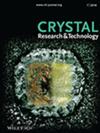Effect of Change in Valence State of Ga During Annealing on the Structural, Optical, and Electrical Properties of GZO Crystals
IF 1.9
4区 材料科学
Q3 CRYSTALLOGRAPHY
引用次数: 0
Abstract
In this work, the ZnO:Ga (GZO) single crystals are grown by the chemical vapor transport (CVT) method. The as‐grown crystals are annealed under an oxygen atmosphere at different temperatures. The GZO crystal's structure and its optical and electrical properties are characterized by X‐ray photoelectron spectroscopy (XPS), Raman spectroscopy, X‐ray diffraction (XRD), UV‐VIS spectrophotometry, and variable‐temperature Hall‐effect measurement. The XPS results indicate that the valence states of the majority of gallium atoms in the GZO crystals undergo transition from the metallic (Ga0) to the non‐metallic state (Gax+) with increasing annealing temperature. The Raman and XRD results show that the compressive stress along the biaxial c‐axis on GZO crystals increases gradually with annealing temperature. Meanwhile, the GZO crystal's transmittance within the range of 300 to 1000 nm is improved significantly from being opaque to about 57%. The GZO crystals exhibit a decrease in free‐carrier concentration (1020–1019 cm−3), an increase in carrier mobility (77.8–87.9 cm2/V−1s−1) and resistivity (10−4–10−2 Ω·cm). The annealed GZO crystal's carrier concentration is practically independent of temperature (90–300 K). These results show that the free‐carrier concentrations are affected by the change of valence states in gallium atoms present in the GZO crystal.退火过程中Ga价态变化对GZO晶体结构、光学和电学性能的影响
本文采用化学气相输运(CVT)法制备了ZnO:Ga (GZO)单晶。生长的晶体在不同温度的氧气气氛下退火。通过X射线光电子能谱(XPS)、拉曼光谱(Raman)、X射线衍射(XRD)、紫外可见分光光度法和变温霍尔效应测量对GZO晶体的结构及其光学和电学性质进行了表征。XPS结果表明,随着退火温度的升高,GZO晶体中大部分镓原子的价态由金属态(Ga0)转变为非金属态(Gax+)。Raman和XRD结果表明,随着退火温度的升高,GZO晶体沿双轴c轴方向的压应力逐渐增大。同时,GZO晶体在300 ~ 1000 nm范围内的透光率由不透明提高到57%左右。GZO晶体表现出自由载流子浓度下降(1020-1019 cm−3),载流子迁移率增加(77.8-87.9 cm2/V−1s−1)和电阻率(10−4-10−2 Ω·cm)。退火后GZO晶体的载流子浓度与温度(90 ~ 300 K)无关。这些结果表明,GZO晶体中镓原子的价态变化会影响自由载流子浓度。
本文章由计算机程序翻译,如有差异,请以英文原文为准。
求助全文
约1分钟内获得全文
求助全文
来源期刊
自引率
6.70%
发文量
121
审稿时长
1.9 months
期刊介绍:
The journal Crystal Research and Technology is a pure online Journal (since 2012).
Crystal Research and Technology is an international journal examining all aspects of research within experimental, industrial, and theoretical crystallography. The journal covers the relevant aspects of
-crystal growth techniques and phenomena (including bulk growth, thin films)
-modern crystalline materials (e.g. smart materials, nanocrystals, quasicrystals, liquid crystals)
-industrial crystallisation
-application of crystals in materials science, electronics, data storage, and optics
-experimental, simulation and theoretical studies of the structural properties of crystals
-crystallographic computing

 求助内容:
求助内容: 应助结果提醒方式:
应助结果提醒方式:


